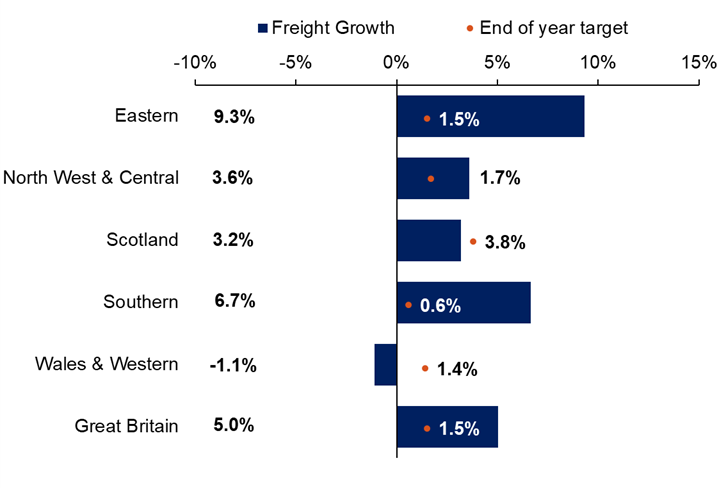Network Rail’s System Operator and National Functions support delivery across its regions, underpinning network-wide operations and providing services on a centralised basis. National Functions consist of corporate services, Route Services and Technical Authority.
We highlighted issues with Network Rail’s processes for agreeing train operator access in 2023. Network Rail’s System Operator responded with improvements to its procedures to manage access applications more effectively. These procedures rely on effective and timely decision making by the Regions, as well as System Operator.
However, in Year 1 Network Rail has received a large number of interacting applications, and these improvements have not been sufficient to enable the System Operator and the affected Regions to make clear and prompt decisions. It is only selling contingent (short-term) access rights on large parts of the network whereas operators require firm rights to plan and invest in rolling stock and train crew for timetables, with particular impact on open access and freight operators.
The short-term access rights process which Network Rail has put in place is not running smoothly for some regions, with applications arriving late to ORR and of insufficient accuracy to reflect the timetable.
We wrote to Network Rail’s System Operator on four occasions during the year, highlighting concerns, seeking improvements to its plans for allocating capacity and asking how it will expedite improvement. We have required it to improve the pace at which it makes decisions on applications for long-term access to the East and West Coast Main Lines to remove barriers to passenger and freight operators to delivering efficiency and growth.
Network Rail produced and published a plan for responding to the applications, agreeing to accelerate aspects of it following ORR’s intervention. While Network Rail has met many of the milestones in this plan, we consider that it could have delivered some of the outputs – in terms of decisions on applications or evidence in response – much more quickly.
In February 2025, Network Rail confirmed its plans did not include it reaching agreement with any operators on access to its network. Instead, it decided to provide information to ORR for ORR to direct access. However, Network Rail only started to provide evidence or information of sufficient detail in April 2025 and will not complete this process fully until the end of July 2025.
While Network Rail has improved its responsiveness recently, it must now sustain this to enable ORR to take decisions in a timely manner for timetables to be legally supported in 2025. If it does not, investment by funders and operators may be put at risk of legal dispute where proposed service changes are not supported by firm access rights.
The System Operator provided good leadership in support of freight growth
In Year 1, rail freight grew by 5%, which was better than the target set of 1.5%. This was due to greater use of biomass (29% growth in Year 1) to generate electricity relative to other sources, and maritime intermodal (9% growth in Year 1) from strong retail activity over Christmas and new year. Construction volumes experienced modest growth partially from HS2 traffic (3% growth in Year 1).
Performance on freight growth was encouraging in most regions. Freight growth in Eastern, North West & Central and Southern was particularly strong, with these regions exceeding the year-end targets set. Scotland missed its target set by 0.6 percentage points and freight decreased on Wales & Western. Despite strong freight growth in Wales, the decline in the aggregates and waste sector in Western has impeded growth across the region.
Freight growth versus targets, by Network Rail region, April 2024 to March 2025

Source: ORR analysis of Network Rail data
Notes: 1. Includes HS1 managed infrastructure; 2. Consistent with the requirements of the Scottish Ministers’ HLOS, Network Rail Scotland uses a different methodology to calculate freight growth compared to the England & Wales regions.
During the year we worked closely with Network Rail as it finalised its freight growth plans. Through this process, we saw evidence of the System Operator providing strong leadership and working closely with the regions as they finalised their plans and established their CP7 freight growth boards.
The System Operator improved timetable development processes
In our PR23 final determination, we required the System Operator to return the preparation of timetables to Network Code timescales. This ensures that timetables are developed such that passengers can buy tickets with confidence 12 weeks in advance of their travel. The System Operator achieved this for the timetable change in December 2024, providing more timely information for rail users to plan their journeys.
The System Operator was also effective in supporting decision making for plans to increase train services on the East Coast Main Line. It recommended the deferral of changes from December 2024 and carried out modelling of performance to support the decision to implement the timetable in December 2025. The modelling gave stakeholders clarity over the expected performance detriment from the planned timetable.
Throughout the process to implement the East Coast Main Line timetable change, the System Operator showed leadership with stakeholders and developed its analytical tools to deliver complex work in a timely way. While we have had good transparency on the delivery of these tools, we remain concerned that a number of the Capacity Planning projects to support future improvements are delayed and will not deliver planned benefits.
Route Services performed well overall
Route Services supports the regions’ maintenance and renewal activities by supplying them with products such as rail, sleepers and track ballast alongside engineering expertise. The function also provides national business services including IT and telecoms, commercial, training and shared services. It achieved 99.44% of planned delivery volumes in Year 1, showing good performance, though marginally short of its own target of 99.48%.
During the year, Route Services launched the Regions and Route Services Partnership Board to enhance collaboration with regional managing directors and align decision-making with customer needs. The board has identified areas for improvement through joint working on reducing fixed costs and enhancing contract efficiency.
In our final determination we highlighted the importance of Route Services delivering on its plans for infrastructure monitoring, to provide regions with vital asset condition data, enabling more efficient and effective planning of maintenance and renewals. The Digital, Data and Technology Services (DDaT) team within Route Services has supported better management of service affecting failures, availability and resilience.
One of the principal CP7 programmes being delivered by Route Services is the Traction Power Centralised Management System (TPCMS) programme. TPCMS is a planning and decision-support tool used by Network Rail to manage and optimise the capacity of the railway’s electrification infrastructure that delivers power to electric trains. During the year, given increases in cost and changes in the scheduled delivery, we raised some concerns with Route Services over the project’s capability to deliver its outputs. Since the end of the year, it has responded with improved reporting and assurance of its project management approach. We will keep this under review.
In June 2025, Network Rail announced that Project Reach, a public-private partnership to deploy new telecommunications cabling around its network, had been contractually agreed. Delays to agreeing the contract impacted Year 1 expenditure, delivery and planned efficiencies. There will now be a lower volume of fibre connections installed in CP7, though Network Rail is confident that it remains on track to complete the project by the end of the next control period.
Good progress in the development of a national traction power strategy and use of innovation funding
In CP6, we identified examples of de-scoped or under-specified upgrades to the power systems that supply electricity to trains (traction power). This highlighted the need for Network Rail to develop a coordinated national approach to the provision of traction power, to help prioritise efficient investment, reduce network constraints and deliver better train performance. During Year 1, we pressed Network Rail’s Technical Authority on the need for a national traction power capability strategy, which it has now produced. We will continue to engage with Network Rail to make sure it is using this strategy when planning network interventions.
In CP7, the Technical Authority, in collaboration with the System Operator, is managing the Industry Performance Improvement Fund (IPIF), a £40 million fund which aims to enhance industry performance for both passengers and freight users. Progress to date has been good, with £3.5 million spent in Year 1 and £8 million committed for Year 2 but focus needs to be maintained on fully utilising the fund.
At the end of Year 1, it had identified 28 schemes and approved 21 of these. Two schemes were completed in the year and nine were in progress. The remaining projects are advancing through the investment authority process. IPIF schemes are already delivering benefits. These include the Northern Trains Double Variable Rate Sanders (technology designed to improve train adhesion) and the Cryogenic Railhead Cleaning project which uses dry ice pellets to clean railheads and remove leaf contamination.
Network Rail’s System Operator and National Functions exceeded their efficiency targets
In the first year of CP7, National Functions delivered £67 million of efficiency savings, exceeding the original CP7 delivery plan target of £53 million by £14 million (26%). Route Services and Technical Authority continued to work closely with the regions to explore additional opportunities to achieve savings.
Route Services delivered £55 million of efficiency savings, £12 million above target. These savings were largely achieved through innovation and technology initiatives and more efficient operational delivery.
Technical Authority delivered £6 million of efficiency savings during the year, exceeding its target by £1 million. These savings were achieved through careful resource management and efficient delivery of capital projects.
The System Operator delivered £5 million of efficiency savings, exceeding its target by £2 million. These savings were achieved through improved contract negotiations and resource management.

